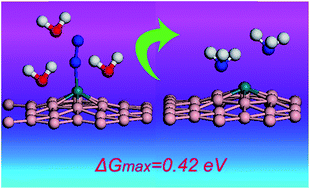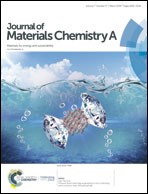Conversion of dinitrogen to ammonia on Ru atoms supported on boron sheets: a DFT study†
Abstract
The prevalent catalysts for natural and artificial N2 fixation are transition-metal (TM) atoms. By using density functional theory computations, several TM atoms embedded on boron sheets as N2 fixation electrocatalysts were investigated in this work. Our results revealed that single ruthenium (Ru) atom-doped boron sheets exhibited outstanding catalytic activity for ammonia synthesis at ambient conditions through the distal pathway with small activation barrier of 0.42 eV; this was less than half of that of the reported flat Ru (0001) catalysts (1.08 eV). These results highlight the value of boron as a substrate for the design of single-atom catalysts due to its unique electron-deficient features.

- This article is part of the themed collections: International Year of the Periodic Table : Single Atoms as Active Catalysts and 2019 Journal of Materials Chemistry A Most Popular Articles


 Please wait while we load your content...
Please wait while we load your content...